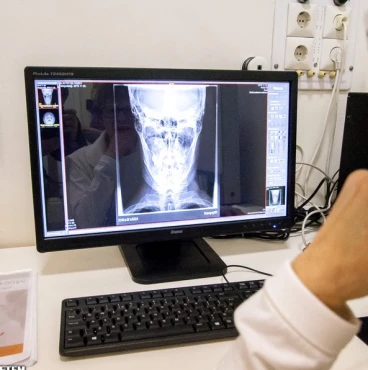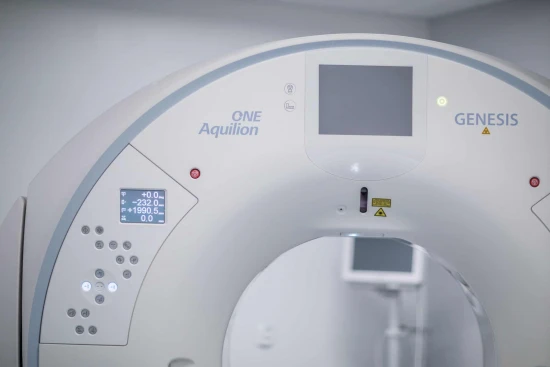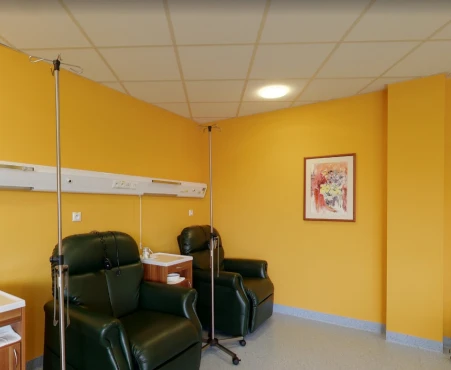Disease Types & Epidemiology
How common is the disease?
Laryngeal cancer is a type of head and neck cancer affecting the larynx or voice box in the throat. The larynx plays a crucial role in sound production and airway protection during swallowing and breathing. Laryngeal cancer incidence varies globally, with higher rates observed in populations with significant tobacco and alcohol use. In the United States, approximately 12,370 new cases are diagnosed annually, primarily in men over 55 years of age.
Laryngeal cancer is categorized based on the affected area within the larynx: supraglottic (upper), glottic (vocal cords), and subglottic (lower). Cancer staging uses the TNM system, which considers the size and extent of the primary tumor, lymph node involvement, and the presence of distant metastasis. Early-stage cancer (stages I and II) is confined to a limited area. In contrast, advanced-stage cancer (stages III and IV) involves larger tumors, potential lymph node involvement, and distant spread.
Causes & Risk Factors
What is the primary issue of laryngeal cancer?
Several risk factors are associated with an increased risk of developing laryngeal cancer, including tobacco use, heavy alcohol consumption, human papillomavirus infection, older age, male gender, occupational exposures, poor nutrition, and gastroesophageal reflux disease [American Cancer Society, 2024].
Clinical Manifestation & Symptoms
What signs should one anticipate while suspecting laryngeal cancer?
Common symptoms include persistent hoarseness, sore throat, difficulty swallowing, chronic cough, ear pain, neck swelling, and breathing difficulties, especially in advanced cases.
Diagnostic Route
When, where, and how should the laryngeal cancer be detected?
- Physical examination: thoroughly evaluates the throat, neck, and lymph nodes.
- Laryngoscopy: visualization of the larynx using a laryngoscope, either indirectly with a mirror or directly with a flexible or rigid scope.
- Biopsy: collection of tissue samples during laryngoscopy for histopathological analysis to confirm the diagnosis.
- Imaging studies: CT scans, MRI, and PET scans are utilized to determine the extent of the disease and guide the treatment plan.
Treatment Approaches
What are the options for managing laryngeal cancer?
Surgical interventions (first-line treatment for any laryngeal cancer stage):
- Transoral laser microsurgery is a minimally invasive procedure that employs a laser to remove early tumors from the vocal cords. This approach is highly successful (>90%) and often allows for preserving the patient's voice.
- Partial laryngectomy, which involves the removal of a portion of the larynx while maintaining the patient's voice, is another surgical option that has demonstrated a reasonable success rate. Approximately 80-90% of patients undergoing this procedure achieve complete early-stage tumor removal.
- Total laryngectomy in advanced-stage disease entails the complete removal of the larynx. It is often necessary for advanced tumors. Following this surgery, patients require a tracheostomy to assist with breathing.
- Neck dissection involves the removal of lymph nodes in the neck if there is evidence of cancer spreading to the lymph nodes (stage III-IV).
Radiation therapy consists of external beam radiation treatment (EBRT – for local stages, the control rate is 85-95%) and concurrent cisplatin-based chemoradiotherapy with a 50-60% response rate in stage III-IV.
Sometimes, physicians may use cetuximab (targeted anti-EGFR therapy) or immunotherapy (nivolumab, pembrolizumab), which also improves response rate by about 13% compared to radiation alone.
Prognosis & Follow-up [Koroulakis & Agarwal, 2024]
How does cutting-edge science improve the lifespan and quality of life for those with laryngeal cancer?
The prognosis for laryngeal cancer varies based on the stage at diagnosis, the tumor's location, and the patient's overall health. Early-stage laryngeal cancer generally has a positive outlook, with 5-year survival rates often exceeding 80-90%. However, advanced-stage cancer tends to have lower survival rates, around 50-60%, due to the increased risk of cancer spreading and recurring.
For glottic squamous cell carcinoma, the overall 5-year survival rate is 77%. If the disease is confined to the larynx, the 5-year survival increases to 84%. However, the survival rate drops to 52% if the cancer has spread to lymph nodes and further decreases to 45% if it has metastasized to distant sites.
The overall 5-year survival for supraglottic squamous cell carcinoma is 45%. When the disease is limited to the larynx, the 5-year survival improves to 61%, but it declines to 46% if the cancer has spread to lymph nodes and further drops to 30% if it has metastasized to distant sites.
For subglottic squamous cell carcinoma, the overall 5-year survival rate is 49%. If the disease is confined to the larynx, the 5-year survival is 59%, but it decreases to 38% if the cancer has spread to lymph nodes and 44% if it has metastasized to distant sites.
Regular follow-up appointments are essential for monitoring any cancer recurrence and managing long-term treatment side effects. Typically, during the first year after treatment, the schedule of follow-up visits every 1-3 months is recommended. In the second year, visits are prolonged every 2-4 months. From the third to fifth year - every 4-6 months, and after five years – once a year.
Each follow-up appointment may involve a physical exam, laryngoscopy, and imaging tests as needed to check for any signs of the cancer returning. Long-term follow-up also focuses on rehabilitation, such as speech therapy and managing chronic issues like swallowing problems and voice changes.































































































